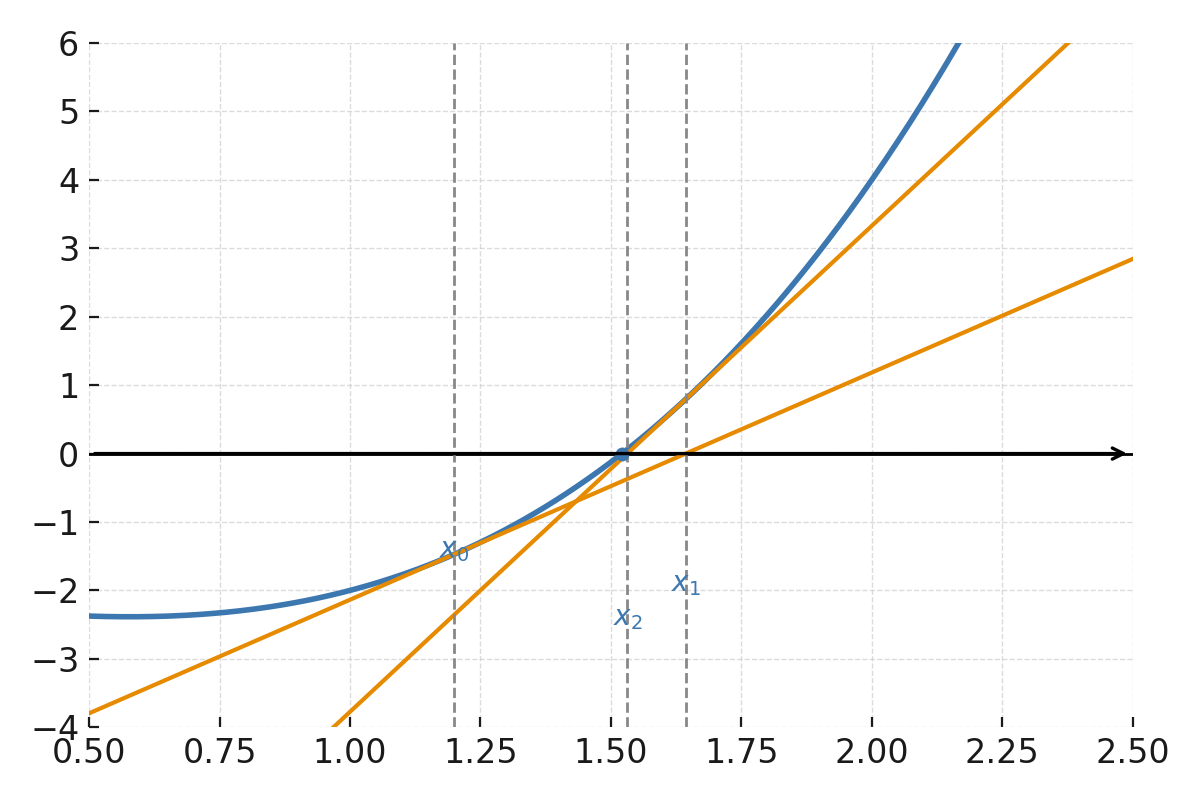Newton-Raphson method
The Newton-Raphson method is a fast numerical technique for finding roots of a function, that is, points where \( \large f(x) = 0 \). The method uses both the function value and its derivative to improve the estimate of the root’s position.
The idea behind the method
The starting point is an initial guess \( \large x_0 \). At the point \( \large (x_0, f(x_0)) \), the tangent to the curve is drawn. The intersection of this tangent with the x-axis is used as the new guess \( \large x_1 \). The process is repeated until the difference between two successive guesses is smaller than a chosen tolerance \( \large \varepsilon \).
Formula
$$ \large x_{n+1} = x_n - \frac{f(x_n)}{f'(x_n)} $$
Step-by-step procedure
- Choose a starting point \( \large x_0 \).
- Calculate \( \large f(x_0) \) and \( \large f'(x_0) \).
- Use the formula to find \( \large x_1 \).
- Repeat until \( \large |x_{n+1} - x_n| < \varepsilon \).
Example
We want to find the root of \( \large f(x) = x^3 - x - 2 \), which we previously solved using the bisection method.
The derivative is \( \large f'(x) = 3x^2 - 1 \).
We choose an initial guess \( \large x_0 = 1{,}5 \).
$$ \large f(1{,}5) = (1{,}5)^3 - 1{,}5 - 2$$
$$ \large f(1{,}5) = -0{,}125 $$
$$ \large f'(1{,}5) = 3(1{,}5)^2 - 1 $$
$$ \large f'(1{,}5) = 5{,}75 $$
$$ \large x_1 = 1{,}5 - \frac{-0{,}125}{5{,}75} $$
$$ \large x_1 = 1{,}5217 $$
After a few iterations, the method quickly converges to the root \( \large x \approx 1{,}521 \).

The function \( \large f(x) = x^3 - x - 2 \). The initial guess \( \large x_0 \) is marked on the x-axis, and the tangent at \( \large x_0 \) is drawn as a line intersecting the x-axis at \( \large x_1 \). Next, the tangent at \( \large x_1 \) is shown, intersecting even closer to the root. The figure illustrates the iterative improvement.
Remarks
The Newton-Raphson method converges much faster than the bisection method, but it requires that the derivative \( \large f'(x) \) can be computed and that the initial guess is close to the actual root. If the tangent is almost horizontal (that is, \( \large f'(x) \approx 0 \)), the method may fail or overshoot the root.